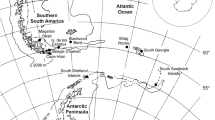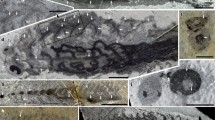Abstract
Synodontis (Mochokidae, Siluriformes) is a freshwater catfish endemic to Africa. The 118 extant species are present in almost all hydrographic basins. Some species are restricted to a single stream, whereas others have a vast distribution. Synodontis is known in the fossil record since the Miocene, and its history depends on the connections among African basins through time. The identification of species in the fossil record is essential to reconstruct this historical pattern. Catfish pectoral and dorsal spines are robust, they preserve well and they form most of the fossil remains for the genus Synodontis. Unfortunately, the criteria for the identification of extant Synodontis species are not applicable to fossil specimens. Here, we define 11 original morphological characters that permit to discriminate four extant species from the Chad-Chari hydrographic system. Six of these characters are defined on pectoral spines and five on dorsal spines. We then show that these characters can be used successfully for identifying fossil specimens. In particular, we present a case study in which we identify Synodontis cf. schall and Brachysynodontis cf. batensoda in the hominid-bearing sector Toros-Menalla (Late Miocene, northern Chad). We show that spine anatomy can be a powerful tool to recognise catfish species through time and thus to identify historical diversity pattern.



Similar content being viewed by others
References
Bermingham E, Martin AP (1998) Comparative mtDNA phylogeography of neotropical freshwater fishes; testing shared history to infer the evolutionary landscape of lower Central America. Mol Ecol 7:499–517
Bianco PG (1990) Potential role of the paleohistory of the Mediterranean and Paratethys Basins on the early dispersal of Auro-Mediterranean freshwater fishes. Ichthyol Explor Freshw 1:167–184
Froese R, Pauly D (2005) FishBase v. 05/2005. http://www.fishbase.org
Gayet M, Van Neer W (1990) Etude ostéomorphologique des épines dorsales et pectorales de quelques silures africains. Rev Zool Afr 104:241–252
Greenwood PH (1951) Fish remains from Miocene deposits of Rusinga Island and Kavirondo Province, Kenya. Ann Mag Nat Hist 12:1192–1201
Greenwood PH (1959) Quaternary fish-fossils. Inst Parcs Nat. Congo Belge, Expl. Parc Albert, Mission Heinzelein Beaucourt (1950) 4:1–80
Greenwood PH (1972) New fish fossils from the Pliocene of Wadi Natrum, Egypt. J Zool 168:503–519
Greenwood PH (1973) Fish fossils from the Late Miocene of Tunisia. Notes Serv Géol Tunisie 37:41–72
Greenwood PH, Howes GJ (1975) Neogene fossil fishes from the Lake Albert–Lake Edward rift (Zaire). Bull Br Mus Nat Hist Geol 26:69–126
Lévêque (1994) Introduction générale: biodiversité des poissons africains. In: Teugels GG, Guégan JF, Albaret JJ (eds) Diversité des poissons des eaux douces et saumâtres d'Afrique, pp 7–16
Luff RM, Bailey GN (2000) Analyses of size changes in incremental growth structures in African catfish Synodontis schall (schall) from Tel El-Amarna, Middle Egypt. J Archeol Sci 27:821–835
Lundberg JG (1993) African–South American freshwater fish clades and continental drift, problems with a paradigm. In: Goldblatt P (ed) Biotic relationships between Africa and South America. Yale University Press, New Haven, pp 156–198
Paugy D, Roberts TR (1994) Mochokidae. In: Lévêque C, Paugy D, Teugels GG (eds) Faune des poissons d'eaux douces et saumâtres d'Afrique de l'Ouest II. MRAC Orstom, collection faune tropicale, pp 500–563
Poll M (1971) Révision des Synodontis africains (famille Mochokidae). Mus Roy Afr Cent Zool 191:1–497
Priem R (1920) Poissons fossiles du Miocène d'Egypte (Burdigalien de Moghara, “Désert lybique”). In: Fourtau R (ed) Contribution à l'étude des vertébrés miocènes de l'Egypte. Gov Press, pp 8–15
Schwartz HL (1983) Paleoecology of late Cenozoic fish from the Turkana Basin, Northern Kenya. Ph.D. dissertation. University of California, Santa Cruz, CA, USA
Stewart KM (1990) Fossil fish from the Upper Semliki. Virg Mus Nat Hist Mem 1:141–162
Stewart KM (2003a) Fossils fish remains from Mio-Pliocene deposits at Lothagam, Kenya. In: Leakey MG and Harris JH (eds) Lothagam, the dawn of humanity in Eastern Africa. Columbia University Press, New York, pp 76–111
Stewart KM (2003b) Fossil fish remains from the Pliocene Kanapoi site, Kenya. Contrib Sci 498:21–38
Van Couvering JAH (1977) Early record of freshwater fishes in Africa. Copeia 1977 1:163–166
Van Neer W (1992) New Late Tertiary fish fossils from the Sinda Region, eastern Zaire. Afr Study Monogr Suppl 17:27–47
Van Neer W (1994) Cenozoic fish fossil from the Albertine Rift Valley in Uganda. In: Geology and palaeobiology of the Albertine Rift Valley, Uganda–Zaire, II: Palaeobiology. Publ Occas CIFEG, pp 89–127
Acknowledgements
We thank the French Ministère de l'Enseignement Supérieur, de la Recherche et de la Technologie (CNRS; Université de Poitiers) and the Chadian authorities (Ministère de l'Education Nationale et de la Recherche, Université de N'Djaména, CNAR). We extend our gratitude to the French Ministère des Affaires Etrangères and to the Région Poitou-Charentes for their support, and to the members of the Mission Paléoanthropologique Franco-Tchadienne. The MPFT fieldwork is also supported by a NSF/RHOI grant. E. Fara acknowledges a CNRS postdoctoral grant. We thank the reviewers and the editor for their comments on the manuscript. Drawings by A. Pinton.
Author information
Authors and Affiliations
Corresponding author
Rights and permissions
About this article
Cite this article
Pinton, A., Fara, E. & Otero, O. Spine anatomy reveals the diversity of catfish through time: a case study of Synodontis (Siluriformes). Naturwissenschaften 93, 22–26 (2006). https://doi.org/10.1007/s00114-005-0051-4
Received:
Accepted:
Published:
Issue Date:
DOI: https://doi.org/10.1007/s00114-005-0051-4




